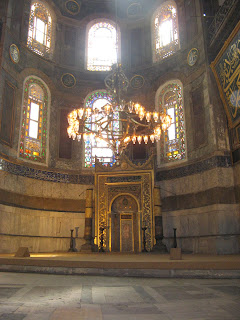 |
| View of Hagia Sophia from the gallery |
 |
| Hagia Sophia |
 |
| Byzantine mosaic in Hagia Sophia |
 |
| Inside Topkapi Palace |
The nearby Topkapi Palace was the main residence of the Ottoman Sultans from 1465 until 1856 when they moved to Dolmabahce Palace on the shores of the Bosphorus. It is a Unesco World Heritage site and is described as "The best example of palaces of the Ottoman period". In its heyday it was home to over 4000 people in what was a walled city spreading over many acres on a headland with wonderful views out to sea. It consists of large courtyards surrounded by multiple buildings, some of which are now treasure galleries housing collections of eye popping jewels, porcelain, weapons, manuscripts and clothes plus holy Islamic relics, including Mohammed's cloak and sword. I loved the clothes gallery, goodness those Sultans must have been absolutely huge, judging by the size of the clothes! I also loved the stunning tiling inside the buildings. We didn't go into the Harem, which cost extra and by late afternoon we were all too tired to bother. Hint: Get to Topkapi early and go to the treasure galleries first to avoid the crowds. We queued to get into the galleries but found strolling the other buildings easy and un-crowded.
Well, what a day, so much seen, so much to take in...all fantastic and made so much more interesting by our eloquent Turkish guide who explained everything clearly.
 |
| Lamps hanging in Hotel Kybele |
Our evening meal was on the rooftop terrace of the delightfully quirky Hotel Kybele. I fell in love with Turkish lamps at the Kybele where literally hundreds, of all different shapes and colours, hang from its ceilings.

Dolmabahce Palace
Next morning a 20 minute walk took us to the waterfront and our own chartered boat for a cruise on the Bosphorus. It was a gloriously warm, sunny day and pleasantly relaxing lounging on large Turkish cushions watching Istanbul's European waterfront slip by. We passed luxury waterfront hotels and expensive homes and then the delicate and exquisite Dolmabahce Palace before landing beside the large stone Fort of Rumeli. This was built in 1451, in an astonishingly short 4 months, to protect the inner harbour of Istanbul. It eventually became a prison and then fell into disrepair but is now largely restored and provides stunning views out to the Golden Horn and down the harbour. We climbed up the steep, perilous, unrailed staircases to the top of the walls to take in the views and then, of course, had to clamber down again which was nerve wracking, to say the least.
 |
| Fort of Rumeli |

 |
We stopped at a picturesque fishing village for lunch where we bought luscious peaches, plums, goats cheese and bread rolls which we ate sitting on the sea wall while watching fishermen mending their nets. I wanted to make a note of the name of the village and seeing a sign carefully wrote it in my diary. Later that day I asked our hotel owner if he knew it, he laughed and told me that what I had written down was "Ferry Landing"

No comments:
Post a Comment